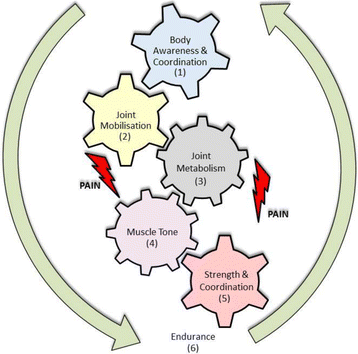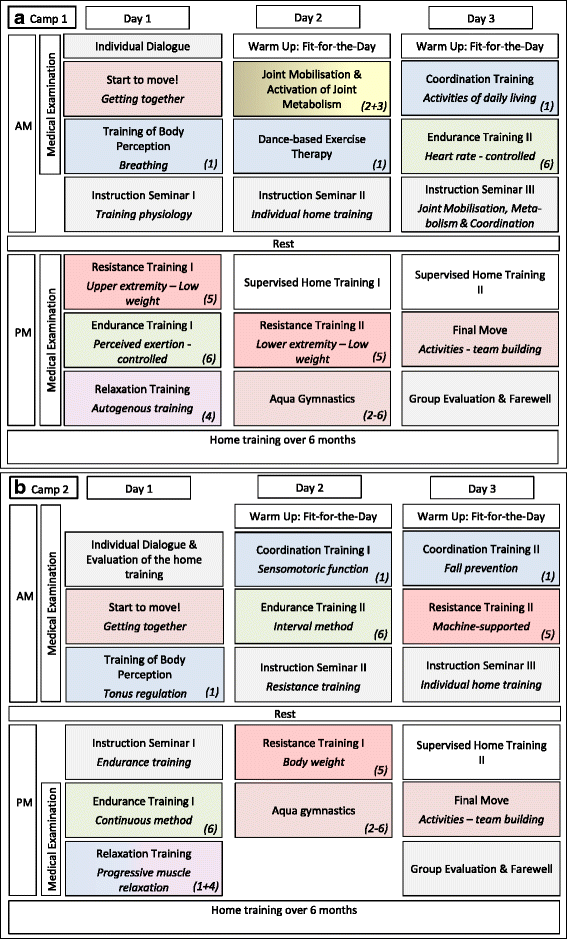Programmed Sports Therapy (PST) in People with Haemophilia (PwH) "Sports Therapy Model for Rare Diseases"
- PMID: 29506547
- PMCID: PMC5836382
- DOI: 10.1186/s13023-018-0777-7
Programmed Sports Therapy (PST) in People with Haemophilia (PwH) "Sports Therapy Model for Rare Diseases"
Abstract
Sports and exercise therapy becomes more and more integrated in the treatment plan of different diseases. Although the benefits of this therapy are of high quality evidence, e.g. in cardiovascular diseases, no concepts of sports therapy are available as a treatment option for rare diseases.During the last eighteen years, we analyzed the situation as well as necessity, and developed a model, contents and the concept of the "Programmed Sports Therapy (PST)" for the treatment of PwH (people with haemophilia) as our model of rare disease. Many studies have shown that motoric skills are depressed in PwH, and that this gap to healthy people increases during age. The only way to reduce this progression is an appropriate therapy, adapted to the necessities of PwH. In haemophilia, in particular, physio- and sports therapy treatments should go hand in hand, the first in the acute phase after bleeding, the second later, after the acute phase has finished. One model, which considers all the different challenges, can be the cogwheel model presented here. Since haemophilia is a rare disease, new training concepts are necessary because classical group therapies are often impossible. PST based on the combination of sports therapy camps together with a supervised autonomous home training helps to directly bring the training to the trainee, in order to enhance key competences and improve the individual situation in PwH, and perhaps in patients with other rare diseases.The experience and scientific data substantiate the success of "Programmed Sports Therapy (PST)" and even this can be a model for other rare diseases.
Keywords: Coordination; Endurance; Exercise; Haemophilia; Physiotherapy; Prevention; Rare diseases; Rehabilitation; Sport; Strength.
Conflict of interest statement
Ethics approval and consent to participate
Not applicable.
Consent for publication
Not applicable.
Competing interests
The author declares that he has no competing interests.
Publisher’s Note
Springer Nature remains neutral with regard to jurisdictional claims in published maps and institutional affiliations.
Figures


Similar articles
-
The evolution of physiotherapy in the multidisciplinary management of persons with haemophilia (PWH): A scoping review.Haemophilia. 2023 Jan;29(1):11-20. doi: 10.1111/hae.14661. Epub 2022 Sep 27. Haemophilia. 2023. PMID: 36167324 Free PMC article.
-
RCT - subjective physical performance and quality of life after a 6-month programmed sports therapy (PST) in patients with haemophilia.Haemophilia. 2017 Jan;23(1):144-151. doi: 10.1111/hae.13079. Epub 2016 Oct 11. Haemophilia. 2017. PMID: 27726259 Clinical Trial.
-
Haemophilia & Exercise Project (HEP): the impact of 1-year sports therapy programme on physical performance in adult haemophilia patients.Haemophilia. 2013 Mar;19(2):194-9. doi: 10.1111/hae.12031. Epub 2012 Oct 8. Haemophilia. 2013. PMID: 23039074
-
RCT of a 6-month programmed sports therapy (PST) in patients with haemophilia - Improvement of physical fitness.Haemophilia. 2016 Sep;22(5):765-71. doi: 10.1111/hae.12957. Epub 2016 Jul 11. Haemophilia. 2016. PMID: 27396815 Clinical Trial.
-
The benefits of exercise for patients with haemophilia and recommendations for safe and effective physical activity.Haemophilia. 2013 Jul;19(4):487-98. doi: 10.1111/hae.12118. Epub 2013 Mar 28. Haemophilia. 2013. PMID: 23534844 Review.
Cited by
-
The evolution of physiotherapy in the multidisciplinary management of persons with haemophilia (PWH): A scoping review.Haemophilia. 2023 Jan;29(1):11-20. doi: 10.1111/hae.14661. Epub 2022 Sep 27. Haemophilia. 2023. PMID: 36167324 Free PMC article.
-
Subjective Physical Performance and Its Determinants in Patients With Haemophilia.Haemophilia. 2025 May;31(3):535-543. doi: 10.1111/hae.70037. Epub 2025 Mar 28. Haemophilia. 2025. PMID: 40153403 Free PMC article.
-
Promoting physical activity in people with haemophilia: the MEMO (Movement for persons with haEMOphilia) expert consensus project.Blood Transfus. 2022 Jan;20(1):66-77. doi: 10.2450/2021.0138-21. Epub 2021 Oct 15. Blood Transfus. 2022. PMID: 34694222 Free PMC article.
-
Establishing an online physical exercise program for people with hemophilia.Wien Klin Wochenschr. 2019 Nov;131(21-22):558-566. doi: 10.1007/s00508-019-01548-1. Epub 2019 Sep 18. Wien Klin Wochenschr. 2019. PMID: 31535221 Free PMC article.
-
Lower physical activity and altered body composition in patients with haemophilia compared with healthy controls.Haemophilia. 2021 Mar;27(2):e260-e266. doi: 10.1111/hae.14259. Epub 2021 Feb 12. Haemophilia. 2021. PMID: 33578451 Free PMC article.
References
-
- Hilberg T. Physical activity in the prevention of cardiovascular diseases. Epidemiology and mechanisms. Hamostaseologie. 2008;28:9–12. - PubMed
Publication types
MeSH terms
LinkOut - more resources
Full Text Sources
Other Literature Sources
Medical
Miscellaneous

